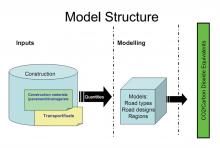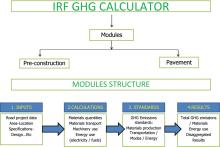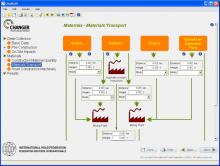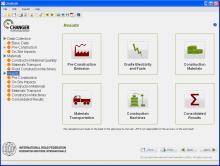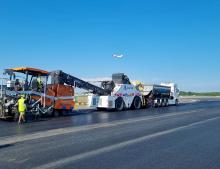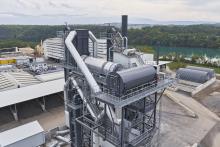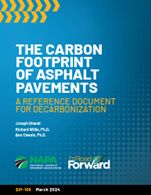Time for CHANGER IRF launches CHANGER, a groundbreaking calculator of greenhouse gas emissions from road construction. Our world is changing, our climate is changing.

Figure 3 left. Materials transport diagram © International Road Federation
Time for CHANGER IRF launches CHANGER, a groundbreaking calculator of greenhouse gas emissions from road construction
Our world is changing, our climate is changing. Industry too is changing to meet the new social, environmental and economic challenges of our times. Already, the road sector has taken a decisive lead in this respect by transforming its practices and adopting new, more eco-friendly techniques and technologies.CHANGER is the latest flagship project in this evolution: the sign of an industry committed to the green economy, and at the forefront of efforts to stimulate change for the better.
Background
No industry can afford to ignore its impact on the environment and on climate change. As we move into the future, better roads must be built by practitioners who are fully aware of the ecological repercussions of their activities, and of the growing potential for enhancing positive while reducing negative impacts. Keen to contribute dynamically to this global endeavour, theCHANGER corresponds to a longstanding need on the part of industry specialists for a comprehensive and reliable tool for assessing, with a view to reducing, direct emissions produced during road construction projects. It takes the form of a user-friendly software package designed to meet the demands of modern industry and today's complex business world.
Objectives
The main objectives of the CHANGER project are to achieve tangible, long-term benefits for the global environment and to contribute proactively to the shaping of dynamic sustainable road development policies going forward.Easy to use, accessibly priced and fully compatible with
The ultimate goal of this tool is multifaceted:
• Facilitate a detailed environmental analysis of road projects;
• Provide an authoritative basis for comparative analysis of various road-building techniques and materials;
• Optimise road construction site supply schemes with respect to raw material providers, choice of suppliers, delivery locations and material transport modes;
• Enable detailed estimation of GHG emissions specifically attributable to the road construction industry.
Concept and modelling approach
CHANGER adopts a comprehensive 'input-output' modelling approach (Figure 1).The calculation model is based on a simple set of equations that enable accurate estimation of overall GHG emissions (outputs) generated by each identified and quantified source (inputs). Dropdown menus and data entry wizards are designed to ensure a structured hierarchy for entering and managing data, as well as enhance user-friendliness at every stage.
Each module follows the same structure (Figure 2). Firstly, the user of the calculator enters input data. Then, a first calculation is carried out in order to obtain the material quantities, material transport, electricity used, etc. These quantities are finally assessed with emissions factors in order to output the total GHG emissions attributable to every stage of the road construction process.
Emissions sources
The calculator has been designed as a flexible tool that can accommodate a wide range of different user needs from 'pre-project phase' estimations right through to comprehensive end-project assessment.CHANGER currently comprises two main modules (Figure 2):
The pre-construction module takes into account:
• Clearing and piling: based on the ground surface area cleared per unit of road surface, an estimation can be generated for both machine use and fuel consumption. Transportation of trees removed is also taken into account.
• Cut exports and fill imports transport to and from the road site: based on a simplified diagram, the user selects the relevant sites and enters the respective distances, tonnages and transport modes (road, rail or inland water).
The pavement module takes into account:
• On-site impacts: electricity and fuel consumption on the construction site, as identified and evaluated.
• Pavement construction materials: this section encompasses several menus (unbound materials, hydraulically bound materials, bituminous bound materials, metals, rubber and plastic, etc.), from which the user can easily select the materials required for construction of the different layers of the given pavement.
• Materials transport: once again, a simplified diagram has been set up to help visualise and assess the emissions generated by transportation of the materials identified (Figure 3):
• For aggregates: two possible quarry sites are considered. Aggregates are transported either directly to the road site (granular materials for sub-base and filter drain) or first to the mixing plants (granular materials used for mixtures) and then to the road site; For bituminous materials: the system considers bitumen transport from the refinery to two possible mixing plant sites, and then from the plants to the road site. The model also accounts for the transport of emulsions directly from refinery to site; For cement: the system caters for both transport of cement directly to the site or via a mixing plant. For concrete: transport of concrete directly to the road site is similarly included as an option.
• Construction machines: The model estimates the number of working hours per type of machine and type of pavement layer. The total consumption of fuel is determined on the basis of the characteristics and efficiency of the material used.
Once assessed, the GHG emissions generated throughout the various stages of the road construction process are converted to carbon dioxide equivalent. Carbon dioxide equivalents are commonly expressed as million metric tonnes of carbon dioxide equivalent (MMTCO2Eq).
CHANGER automatically generates comprehensive reports - either aggregated (total) or disaggregated (inherent to only one or more steps of the process) - that can be conveniently exported to Excel, Word, PDF and HTML (Figure 4).
Validation process
By virtue of its extensive and varied membership - both in terms of geographical coverage and fields of specialisation - IRF has benefited from technical support from a wide range of industry and technical partners throughout the development of the project. This has been particularly invaluable for ongoing review and validation of the modelling approach and databases, as well as for testing and comparison.The
Future developments
CHANGER has been conceived as an evolving tool, subject to ongoing review and development so that it ultimately covers every phase and aspect of road construction. Already, work is underway on complementing the existing pre-construction and pavement modules with a new module devoted to maintenance activities. Similarly, the databases will be regularly updated to reflect the very latest science as well as cutting-edge research on techniques, materials and equipment.Among countless benefits, CHANGER is designed to stimulate environmental awareness and best practice throughout the road sector; enhance competitive advantage; provide an authoritative reference for comparing methods, technologies and materials, and highlight potential for significant financial economies on material costs and energy consumption Furthermore, CHANGER provides a unique 'future proofing' opportunity for road construction companies to act both responsibly and proactively by constituting their own greenhouse gas inventories, with the aid of a credible and transparent methodology, in advance of mandatory national regulations.
An additional advantage of thinking ahead and taking foresighted steps to reduce emissions is that more and more international financial institutions are progressively including compulsory GHG emissions assessments of road construction projects in their tendering procedures.
CHANGER also offers a universal benchmark for the industry to "reduce what it can, offset what it can't." Participation in independent offsetting programmes made possible by CHANGER will enable the road sector to be part of a new heritage for the planet by directly involving communities in global efforts to combat climate change while giving them new means for a sustainable future in terms of health, education, employment and self-sufficiency.
CHANGER is symbolic of an industry committed to making a difference on a scale commensurate with the magnitude and urgency of the challenges facing our planet.
Roads have long been the drivers of economic and social progress. Now there is a unique opportunity for them to pioneer parallel and proportionate progress on the environmental front.
For more information on CHANGER, as well as details on how to order your CD-ROM copy of the software, go to %$Linker:

